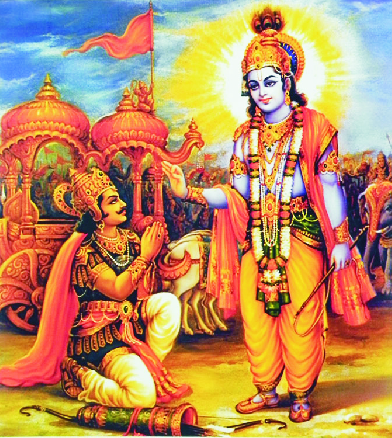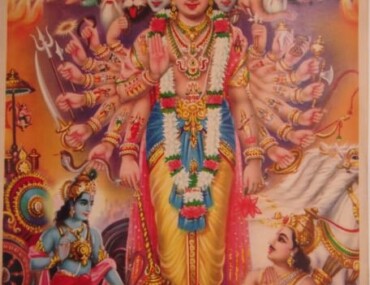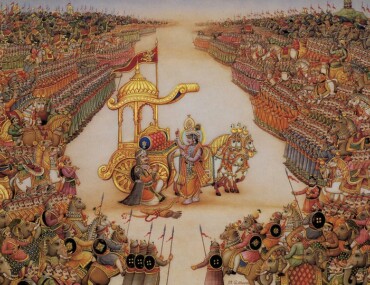The detailed discussion of the message of Mahabharata of Vyasa, the true Tara-Tamya Dharma, we should take note of. Only then we shall be in a position to understand how to decide our own course of action correctly when such an occasion of taking a right decision arises in our life. This the important lesson for us as the benediction of Geeta.
In this context we can mention a couple of other such occasions in the Mahabharata. There also Shri Krishna has explained in his inimitable manner to Arjuna, his true dharma. At the same time, He himself also, has followed his own true Satyadharma.
In the first of instance – on the very first day of the Mahabharat war, Bhishmacharya had wreaked havoc on the Pandava army. Seeing this Pandavas were highly agitated. Next day when the war started again the Pandava army gave a fitting reply and in turn decimated the Kaurava army which was demoralized. Duryodhan, the eldest Kaurava, angrily confronted Bhishma, and taunted him, “You are not fighting with your full might because you have soft corner for the Pandavas”.
Bhishma, hearing this admonition from his nephew, angrily retorted, “I am now an old man, yet today I shall do my best.” Then followed a terrible war between Bhishma and Arjuna. The Pandava army also suffered large scale havoc. None could contain Bhishma in his terrible mood. Seeing this, best warrior Satyaki also came to the help of Arjuna. Yet Bhishma’s onslaught continued. Shri Krishna Himself became angry. He said to himself, “The present situation is not good augury. Now I myself will have to take the life of Bhishma.”
However, before the war began, Krishna had declared his decision that he himself will not bear weapons, only He will give guidance whenever needed. In spite of this, He remembered his famous formidable weapon, ‘Sudarshan Chakra’ – (a serrated steel disk, flung at the enemy, will severe his throat and return to his finger, appeared on his finger). Immediately He got down from the chariot and angrily confronted Bhishma, ready to use the Chakra. Bhishmacharya was also surprised to see him thus. He stopped the battle, came down from his chariot and folding his hands, said ‘Madhava, You have come! I offer my salutations to you. If I am slayed by your divine hands, then my life here on earth and beyond, will both be fulfilled. While all this was going on, luckily Arjuna regained consciousness, came and tried to stop Shri Krishna saying, ‘Shri Krishna, please contain your anger. Please do not break your decision. I am here, strong enough to fulfill my pledge and shall destroy all the Kauravas. Surely I will do so; I once again pledge on the life of my brothers and sons. Please do not worry.’ Then Krishna refrained from battle.
This whole episode in Mahabharat is instructive. It expounds the ‘Tara Tamya’ philosophy of Shri Krishna. It explains to us exactly how we should weigh the better and best action on our part when faced by a difficult situation in our life! Really the vow taken by Shri Krishna that I shall not take up weapons in my hand in the Mahabharata war was his personal pledge. But when faced with a situation in one’s life, which seriously adversely impact on the justice for whole society, then we are duty bound to follow ‘Samashti-sharana’ – Dharma. It is important for us to choose True Dharma which protects the whole society. It is clear that Shri Krishna himself has shown by this example in his life. A further point to note is seeing that Arjuna, best warrior has taken up his Gandiva bow ready to fight, Shri Krishna accepted his emphatic request and refrained from entering the war. He did not insist on ‘Me’ and ‘My Action’.
Again Shri Krishna has emphatically advised this same attitude of “Vivek-buddhi”, considering right and wrong, to Arjuna at the time of destroying the warrior Jayadratha. That episode is also instructive. What happened was that on the 10th day of the war, by Arjuna’s arrow, Bhishma was critically injured and fell from his chariot. He could no longer lead the Kaurava Army. On the eleventh day, Guru Dronacharya, became the leader of the Kaurava army. He arraigned the Karuava army in a special ‘Chakra Vyuha – strategic arrangement. In the Pandava army, only Arjuna knew how to destroy this Vyuha, how to enter successfully and the exit from it. But Arjuna was tied up that day as Duryodhana had sent first Susharma and thereafter Bhagadatta to fight him.
In this situation Pandavas were faced with the question, as to who can be asked to fight this battle in the absence of Arjuna, to destroy the enemy forces. In the event Abhimanyu, Arjuna’s son came forward to fight as befitting a courageous young man. However he knew how to break in the fortification but did not know how to exit from it. Bhima and others helped him but they were detained outside at the entrance itself by Jayadratha. They therefore could not enter to help. Abhimanyu alone continued to give a tough fight to the enemy. As against that, Dronacharya, Karna, Dushasana, Shakuni and others together fought and killed Abhimanyu.
On this side Arjuna returned after having Killed Bhagdatta and defeating Susharma. He came to know how fraudulently they had killed his son, Abhimanyu. Arjuna, in fit of extreme anger, pledged; ‘Tomorrow, before sunset, I shall destroy Jayadratha, failing which, I shall enter fire and end my life.”
Next day the war was resumed,. Arjuna was at his best fighting the enemy. However, Kauravas were also forewarned and prepared. They had prepared two formations, one in front and another behind it; and placed Jayadratha in the later, thus providing him full protection. Hence Arjuna was getting late to break open the second formation. Yet, in the end he did it. Exactly just at that time, the Sun in the west, was covered with dark clouds. They were all misled by this and rejoiced, and Jayadratha came forward. At the moment, Krishna brought the chariot in front of Jayadratha. As the clouds disappeared, it became clear that the Sun has not yet set.
Shri Krishna immediately told Arjuna, “Look, the Sun has not yet set, and there is Jayadratha.” Arjuna instantly taking the cue shot an arrow and killed Jayadratha. Pandava whole heartedly rejoiced. Arjuna’s vow was fulfilled. He was victorious. But this incident in Mahabharata, and the entire situation surrounding it demands our careful attention. Here itself, the Tara – Tama Bhaav as described by Shri Krishna neatly comes into focus once again. The reason is this: After the episode, Shri Krishna said to Arjuna, “O Arjuna, I did not say anything to you before. Your action of taking this vow, was ‘Atataayi’(inappropriate). This vow was impractical, putting your own self out on a limb. The earlier vow that I shall destroy Jayadratha was O. K. But the later part that ‘I shall kill Jayadratha tomorrow before sunset and if I fail to do so I shall enter fire and court death’, was extreme and unwise. There was no wisdom, ‘Sarasar Viveka’: no proper understanding of what is good and what is bad. No ‘Vivek – Buddhi’.
This is the ‘Tara-Tama-Bhaava’ and its clear glimpse is there in Shri Krishna’s own life and actions as much as in his sage teaching and philosophy in the Bhagawad Geeta. This ‘Tara-Tama bhaava’ means the most important ‘Santulan’, balance required in our life. It is indispensable to achieve the highest goals in human life. Bhagawad Geeta calls it ‘Vivekbuddhi’. It is the teaching of Bhagawad Geeta – the Shastra of Tara-Tamya. In fact the Bhagawad Geeta gives us the four sutras as follows: –
Balance in each event in our life.
Take into account all aspects of any event or contemplated action.
Extremes in any event should be avoided.
Taratamya Bhaav and Saaraasara Vivek should guide all our actions.
These four sutras are highly important. Where in the Geeta, these are specifically quoted? Where Taratamya is mentioned? Where is santulan? Were Samabhava’? And Saarasaar? The answer is: These references are at many places in the Geeta. For example: Aahar – Vihar, Dhyan – Dharana (Meditation – concentration), Charity – hard work, Trushnaa – Greed, Pratikaara (Response)- Vows, body and mind control, Freedom from attachment of all kinds, and finally ‘Prapanch’ – worldly exertions, and ‘Paramartha’ helping others! Similarly, Gnyana Yoga, Dhyana Yoga, Karma Yoga and Bhakti Yoga, in all four of these Yogas and in Parmarthik Saadhan Yoga also, connectedness and continuity is essential. Evenness of Mind is required. This is essentially the great teaching of the Bhagawad Geeta.


